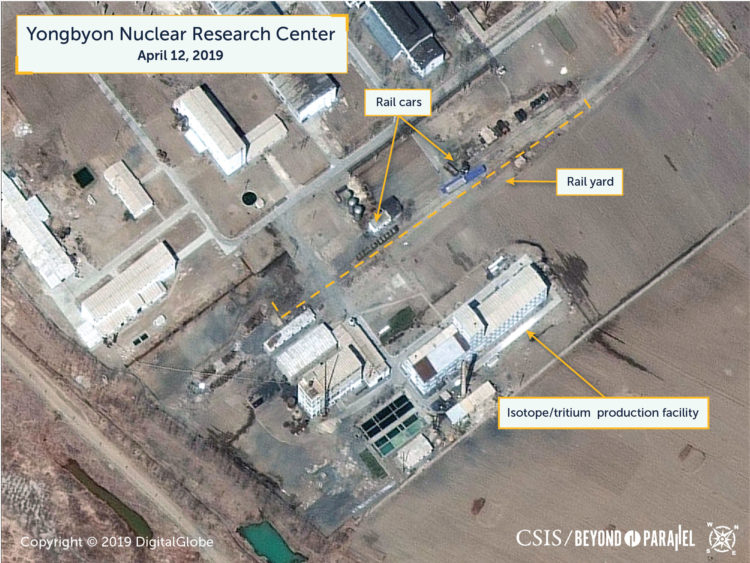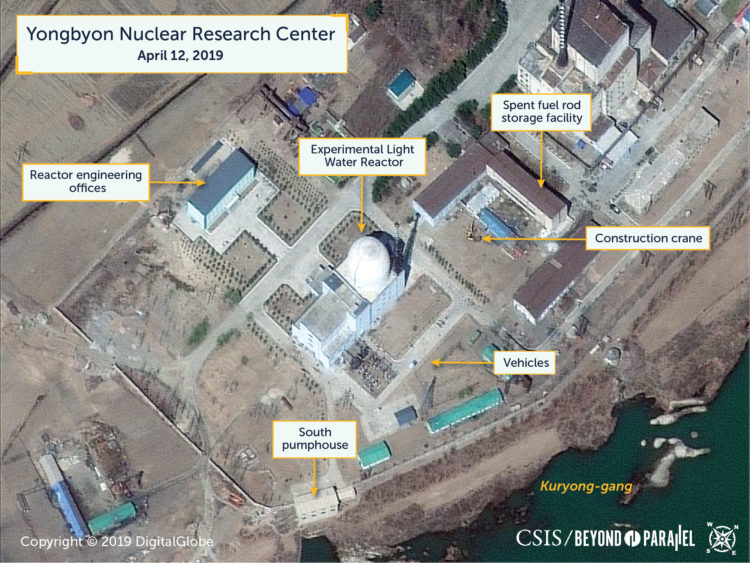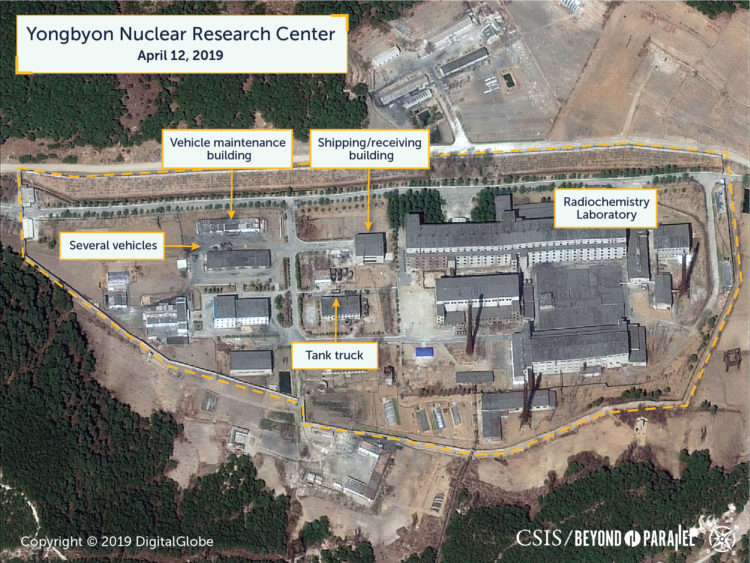
Yongbyon: Movement of Specialized Railcars May Indicate Transfer of Radioactive Material
Key Findings
- DigitalGlobe satellite imagery of North Korea’s Yongbyon Nuclear Research Facility acquired on April 12 shows the presence of five specialized railcars near the Uranium Enrichment Facility and the Radiochemistry Laboratory.
- In the past these specialized railcars appear to have been associated with the movement of radioactive material or reprocessing campaigns. The current activity, along with their configurations, does not rule out their possible involvement in such activity, either before or after a reprocessing campaign.
- IRT-DPRK Reactor: What appears to be a large construction crane is present on the road just west of the reactor building. No readily apparent reason for its presence can be determined at present.
- Kuryong River Dam: The spring snowmelt and runoff noted in our previous report has continued to maintain a high level of water in the Kuryong-gang and water is still overflowing the earthen dam at several points. The current concern is that if this condition continues it may cause a significant breach that could quickly expand and erode major sections of the dam, which could appreciably degrade the quantity of cooling available to the reactors.
- Radiochemistry Laboratory: Only notable activity is the presence of several vehicles in the vehicle maintenance area and what appears to be a tanker truck on the road south of the shipping/receiving building.
- Uranium Enrichment Plant: The only notable activity is the presence of what appears to be a 20-foot shipping container in the utility yard on the west side of the facility.
- Elsewhere, throughout the facility, the level of activity appears to be typical of spring during the past several years.
Yongbyon Nuclear Research Facility
DigitalGlobe satellite imagery of North Korea’s Yongbyon Nuclear Research Facility acquired on April 12t shows the presence of specialized railcars near the Uranium Enrichment Facility and the Radiochemistry Laboratory. In the past these specialized railcars appear to have been associated with the movement of radioactive material or reprocessing campaigns. Elsewhere, throughout the facility, the level of activity appears to be typical of spring during the past several years. Continued spring snowmelt and runoff have maintained a high level of water in the Kuryong-gang, which continues to overflow the earthen dam adjacent to the 5 MWe and Experimental Light Water (ELWR) reactors.
Railcar Activity
Notable in the April 12, 2019 image is the presence of five specialized railcars in the southern section of the Yongbyon Nuclear Research Facility.
Similar rail cars have been previously observed at the Pungang-ni Railyard (the main rail yard serving Yongbyon), shipping/receiving building at the Radiochemistry Plant and in the rail yard servicing the Uranium Enrichment Plant and Isotope/Tritium Production Facility. These observations have notably been both prior to, and after, reprocessing campaigns at the Radiochemistry Plant.



This, along with their configurations, suggests their involvement in the transportation of radioactive material (e.g., waste, contaminated material, etc.). However, this remains to be confirmed. These five specialized rail cars consist of:1
- One, approximately 10-meter-long, flatcar carrying four large casks.2 This car is located approximately 500 meters northwest of the Radiochemistry Plant. This is a somewhat odd location for any railcar as it is sitting by itself on the main line servicing the southern section of the facility. The reason for this positioning is unknown.
- Two, approximately 13-meter-long, depressed-center flatcars carrying four large casks are located in the railyard servicing the Uranium Enrichment Plant and Isotope/Tritium Production Facility. Depressed-center flatcars are typically used for transporting heavy or large loads.3
- Two, approximately 12-meter long, blue bulkhead flatcars are located in the railyard servicing the Uranium Enrichment Plant and Isotope/Tritium Production Facility. While bulkhead flatcars are not necessarily unusual on most railroads around the world, they are not often seen in North Korea.
- Additionally, in North Korea their being painted blue is uncommon. One of the two cars is loaded with what may be a shipping container, large crated piece of equipment, or similar sized load. What appear to be two large trucks are positioned alongside the flatcar with the large load. Several times in the past, two similar railcars (although not painted blue) have been observed at this same railyard along with the specialized flatcars noted above. The concurrent appearance suggests that they are also connected to the transportation of radioactive material.
IRT-DPRK, 5 MWe and ELWR Reactors



At the IRT-DPRK reactor, on the north side of the Yongbyon complex, what appears to be a large construction crane is present on the road just west of the reactor building. No readily apparent reason for its presence can be determined at present.
Although several vehicles are observed around both the 5 MWe and ELWR reactors, it is unlikely that either is in operation at presence as there are no visible indications (e.g., steam rising from the turbine building, distinctive waterflow patterns from the pumphouses, etc.) and the water channel leading to the North pumphouse is partially blocked by sand from ongoing dredging operations just 75 meters upstream. Dredging operations further upstream of the North pumphouse and downstream of the South pumphouse continue. Such activity, although normal for this section of the river, would likely present challenges to cooling water filtration during reactor operations.
A construction crane, first observed several weeks ago, is still present at the Spent Fuel Rod Storage Building—the structure between the 5 MWe reactor and ELWR.
Kuryong-gang Dam
The spring snowmelt and runoff noted in our previous report has continued to maintain a high level of water in the Kuryong-gang and water is still overflowing the earthen dam at several points. Originally constructed during late 2017 to early 2018, the dam is designed to raise the level of the river during the drier summer, fall and winter months thereby enabling a more consistent flow of water to the pumphouses that provide cooling water for the reactors. While spring runoff has been observed overflowing the dam in 2018 and has been repaired, the current concern is that if this condition continues it may cause a significant breach that could quickly expand and erode major sections of the dam. Which, in turn, could appreciably degrade the quantity of cooling available to the reactors.
Elsewhere along the Kuryong-gang dredging operations for gravel and sand are again observed both upstream and downstream of the dam. Such activities are normal for this section of the Kuryong-gang and have been ongoing for many years.
Elsewhere along the Kuryong-gang dredging operations for gravel and sand are again observed both upstream and downstream of the dam. Such activities are normal for this section of the Kuryong-gang and have been ongoing for many years.
Radiochemistry Laboratory


Aside from the notable presence of the specialized railcars noted above the only activity of note observed at the Radiochemistry Laboratory—where plutonium reprocessing is conducted—is the presence of several vehicles in the vehicle maintenance area and what appears to be a tanker truck on the road south of the shipping/receiving building. While tanker trucks have only rarely been observed here in commercial satellite imagery the presence of vehicles at the vehicle maintenance area is consistent with what has observed in the past.
No railcars are present at the shipping/receiving building or nearby warehouse and no plumes are observed from any of the laboratory’s stacks or cooling buildings.
No activity of note is observed at “Building 500”—immediately east of the Radiochemistry Laboratory and historically used for radioactive liquid waste from the Radiochemistry Laboratory. The minor excavation activity that was observed at the southwest corner of Building 500 in our February report, appears to have been completed and the ground graded. The nature and purpose of that previous activity is unknown.
No activity of significance is noted at the thermal plant further to the east and no exhaust plume is present indicating that the plant is not running.
Uranium Enrichment Plant and Isotope/Tritium Production Facility

Aside from the notable presence of the specialized railcars noted above no activity of significance is observed at the Isotope/Tritium Production Facility. The only activity of note observed at the Uranium Enrichment Plant is the presence of what appears to be a 20-foot shipping container in the utility yard on the west side of the facility.
References
- All measurements are approximate due to the 50cm ground sensor distance (i.e., resolution) of the imagery. ↩
- While the objects on the various flatcars appear to be casks they could just as easily be tanks of some sort. ↩
- The reason for the use of two different types (depressed-center and straight) and classes (10-meter and 13-meter) of flatcars is unclear as both are loaded with four casks of similar sizes. ↩



